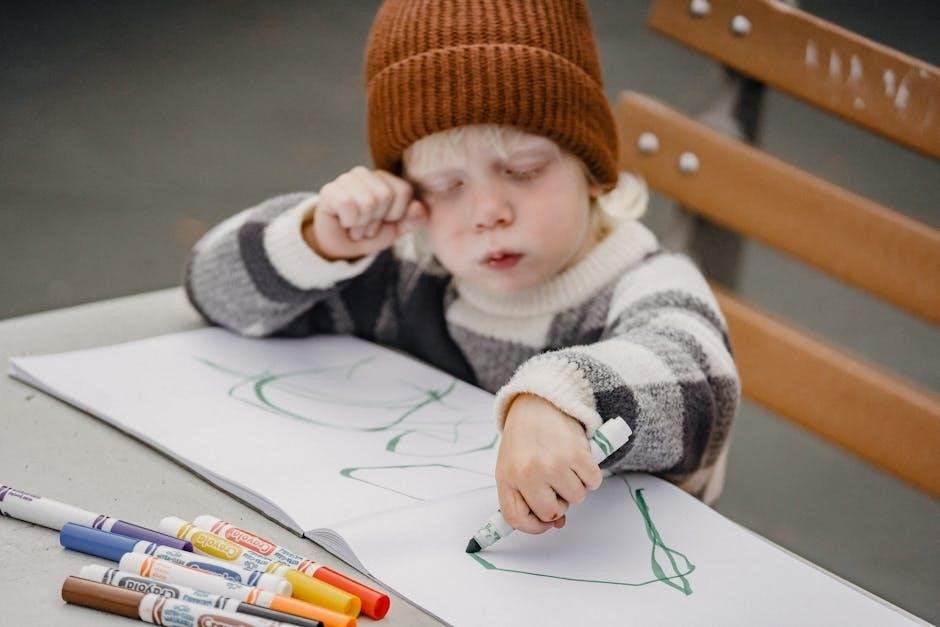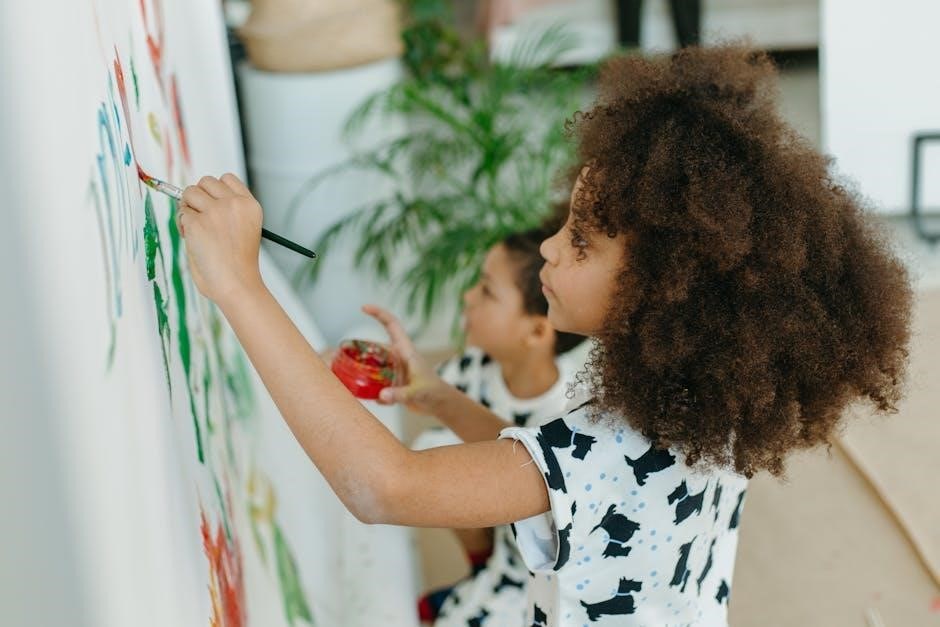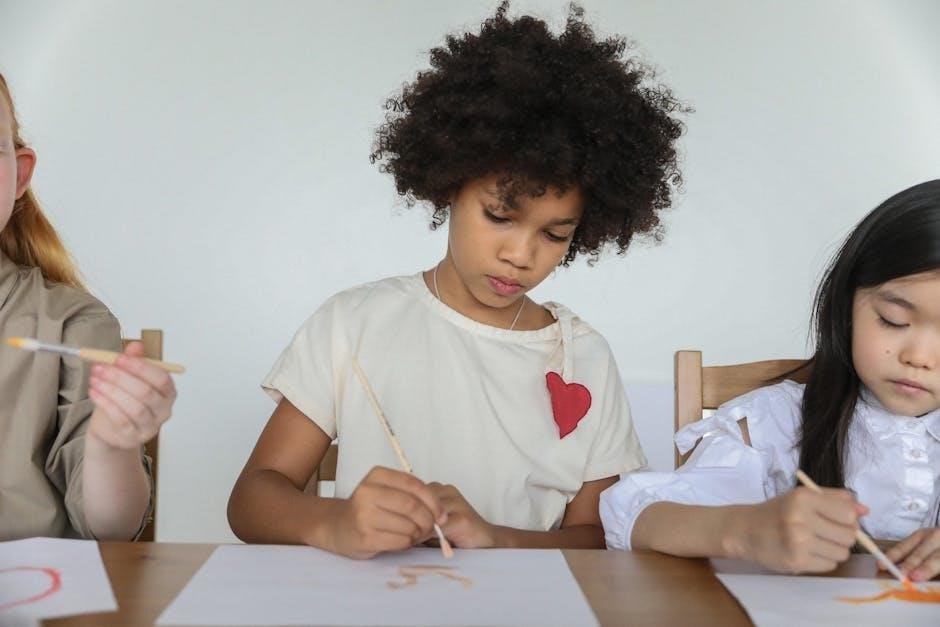The Listen and Draw activity is an engaging method that enhances creativity and listening skills through audio descriptions, enabling participants to visualize and illustrate stories or concepts effectively.
What is a Listen and Draw Activity?
A Listen and Draw activity is an interactive exercise where participants listen to verbal descriptions, stories, or instructions and then create visual representations through drawing. This method encourages auditory processing, creativity, and fine motor skills. It is often used in educational and therapeutic settings to enhance focus and imagination. The activity can be adapted for various age groups and skill levels, making it a versatile tool for learning and self-expression. By linking hearing to creativity, it fosters a deeper connection between comprehension and artistic interpretation.
Benefits of Listen and Draw for Learning and Creativity
The Listen and Draw activity enhances cognitive development by connecting auditory and visual processing, improving memory and concentration. It fosters creativity, allowing individuals to interpret and express ideas uniquely. This method also builds confidence, as participants see their imagination take physical form. For younger learners, it supports language comprehension and fine motor skills, while for older participants, it encourages critical thinking and artistic exploration. Overall, it bridges listening and creativity, making it a powerful tool for holistic development and self-expression across all age groups.

Why Listen and Draw is Popular in Educational Settings
Listen and Draw is widely embraced in education due to its engaging and interactive nature, fostering active participation and focus. It caters to diverse learning styles, making it inclusive for visual, auditory, and kinesthetic learners. The activity bridges language development with artistic expression, encouraging creativity while reinforcing comprehension. Educators appreciate its versatility, as it can be adapted to various subjects and age groups. Additionally, it provides immediate visual feedback, allowing teachers to assess understanding and engagement effectively. Its simplicity and effectiveness make it a favorite in classrooms worldwide for enhancing both skills and enjoyment.

Materials and Preparation
Gather paper, markers, crayons, glue, scissors, and audio equipment. Prepare a quiet space with clear audio output, ensuring all materials are easily accessible for participants.
Essential Materials Needed for the Activity
The core materials include paper, markers, colored pencils, crayons, glue, scissors, and audio equipment for clear sound playback. Ensure high-quality tools for vibrant creativity. A quiet, well-lit space with minimal distractions is crucial. Optional items like stickers or stencils can enhance engagement. Arrange seating to promote focus and comfort, allowing participants to easily hear instructions and express their imagination freely.
How to Prepare the Environment for Maximum Engagement
Arrange tables and chairs to allow easy movement and visibility. Ensure the space is quiet, well-lit, and free from distractions. A clean, organized environment inspires creativity. Display examples or visuals to spark imagination. Position audio equipment centrally for clear sound. Keep materials within easy reach to minimize disruptions. Test technology beforehand to avoid technical issues. Create a welcoming atmosphere with bright colors or calming decor to encourage focus and enthusiasm. A well-prepared space sets the foundation for an engaging and productive Listen and Draw session.

Step-by-Step Instructions for Conducting the Activity
Introduce the activity, provide clear instructions, play the audio, and allow time for drawing. Encourage creativity and focus, ensuring a smooth and enjoyable experience for all participants.
Begin by introducing the Listen and Draw activity, explaining its objective: to enhance creativity and listening skills through visual interpretation. Clearly outline the process, emphasizing the importance of focus and imagination. Ensure participants understand they will listen to a descriptive audio or verbal instructions and then translate what they hear into a drawing. Provide materials like paper and drawing tools, and set expectations for engagement and creative freedom. Encourage questions to ensure clarity before starting the activity, fostering a positive and productive environment for all involved.
Step 2: Delivering Clear and Engaging Instructions
Deliver instructions in a clear, concise, and engaging manner to ensure participants understand the task. Speak slowly and use descriptive language to paint a mental picture. Provide examples or visuals to clarify expectations, if needed. Encourage participants to ask questions before beginning. Emphasize the importance of focusing on the audio and translating heard descriptions into their drawings. Keep instructions positive and motivating to foster creativity and participation. Ensure all materials are within reach and the environment is conducive to focus and imagination.
Step 3: Playing the Audio or Providing Verbal Descriptions
Play the selected audio or deliver verbal descriptions clearly and at a moderate pace. Ensure the volume is adequate for all participants to hear without strain. If using verbal descriptions, speak vividly to inspire imagination. Pause briefly between key details to allow time for drawing. Maintain engagement by using expressive tone and language. Encourage participants to focus solely on the audio and translate the descriptions into their artwork. Avoid interruptions and ensure the audio or verbal cues are concise and easy to follow, fostering creativity and focus among all participants.
Step 4: Allowing Time for Drawing and Creativity
Provide a set time for participants to draw based on age and activity complexity. Ensure the environment remains calm and free from distractions. Allow participants to interpret the audio or descriptions freely, fostering creativity and personal expression. Monitor progress subtly without interrupting their flow. Encourage imagination and exploration of ideas during this phase. After the time concludes, prepare participants to share their work, promoting pride in their creations and fostering a sense of accomplishment and collaborative enjoyment among the group.

Age-Specific Modifications
Adapt the activity’s complexity and instructions according to the participants’ age, ensuring it suits their developmental stage and enhances engagement effectively for diverse groups.
Adapting the Activity for Young Children
For young children, simplify instructions and use visual aids to enhance understanding. Incorporate short, engaging audio clips with familiar themes, such as animals or fairy tales. Provide basic drawing tools like crayons or washable markers. Break the activity into shorter sessions to maintain their attention. Encourage creativity by allowing them to interpret the audio freely. Offer positive reinforcement to build confidence and motivation. This approach ensures the activity is both fun and developmentally appropriate for young participants.
Adjusting Instructions for Older Students or Adults
For older students or adults, provide more complex audio content, such as detailed descriptions or literary passages. Allow additional time for processing and drawing to accommodate deeper reflection. Encourage the use of symbolism or abstract interpretations to challenge their creativity. Consider offering optional background music or ambient sounds to enhance focus. Provide constructive feedback that highlights unique interpretations and techniques. This approach fosters critical thinking and artistic expression while catering to their advanced cognitive and creative abilities.


Common Challenges and Solutions
Addressing distractions and ensuring clear comprehension are key challenges. Solutions include creating a quiet environment, simplifying instructions, and encouraging questions to clarify expectations effectively.
Managing Distractions and Maintaining Focus
To minimize distractions, create a quiet environment and ensure participants are seated comfortably. Use clear, engaging instructions to capture attention. Encourage active listening by providing visual aids or examples. For younger children, incorporate movement breaks to refocus energy. Positive reinforcement, such as praise for concentration, can motivate participants. For older students, emphasize the importance of focus and offer periodic reminders. By structuring the activity thoughtfully, distractions can be reduced, fostering an engaging and productive experience for all ages.
Handling Incorrect Interpretations of Instructions
If participants misinterpret instructions, clarify promptly with examples or visual aids. Encourage questions to ensure understanding. For younger children, simplify language and demonstrate steps. For older participants, provide detailed explanations. Positive reinforcement helps reduce anxiety and fosters creativity. Reviewing instructions step-by-step ensures alignment with expectations. By addressing misunderstandings early, the activity remains engaging and effective, promoting confidence and clear communication among all participants.
Assessment and Feedback

Assessment involves observing participation and creativity, while feedback focuses on constructive criticism, highlighting strengths and suggesting improvements to enhance learning and artistic growth.
How to Observe and Evaluate Participation
To effectively observe participation, focus on attentiveness and creativity during the activity. Evaluate how well participants translate audio descriptions into visual representations. Assess their ability to follow instructions and express ideas through art. Note individual engagement levels and willingness to explore creative interpretations. Use these observations to provide constructive feedback, highlighting strengths and areas for improvement. This approach ensures personalized growth and reinforces the learning objectives of the Listen and Draw activity.
Providing Constructive Feedback to Participants
Constructive feedback is essential for fostering growth and improvement. Focus on specific aspects of the participant’s work, such as creativity, attention to detail, and interpretation of instructions. Highlight strengths and offer actionable suggestions for refinement. Encourage participants to reflect on their process and explore new techniques. Positive reinforcement and open dialogue create a supportive environment, helping participants refine their skills and build confidence in their artistic and listening abilities.
The Listen and Draw activity effectively enhances creativity, listening skills, and self-expression. It encourages participants to explore their imagination while developing essential cognitive abilities through engaging practice.
The Listen and Draw activity is a creative and educational tool that enhances listening, comprehension, and artistic skills. It involves audio descriptions or verbal instructions that participants interpret through drawing; This method fosters imagination, focus, and self-expression while encouraging engagement and collaboration. Suitable for all ages, it adapts to different learning levels, making it versatile for educational and therapeutic settings. By combining auditory and visual elements, it provides a holistic learning experience that promotes cognitive development and creativity. Regular practice can lead to improved communication and problem-solving abilities.

Encouraging Continued Practice and Exploration
Consistent practice in Listen and Draw activities helps refine skills and fosters creativity. Encourage participants to explore different themes and techniques, keeping the process enjoyable. Provide varied audio prompts to maintain interest and challenge their imagination. Regularly reviewing their progress and discussing their interpretations can build confidence. Creating a supportive environment where mistakes are seen as learning opportunities motivates continued engagement. Inspire participants to apply their skills in real-world contexts, such as illustrating stories or designing visuals for projects, to deepen their understanding and enjoyment of the activity.
